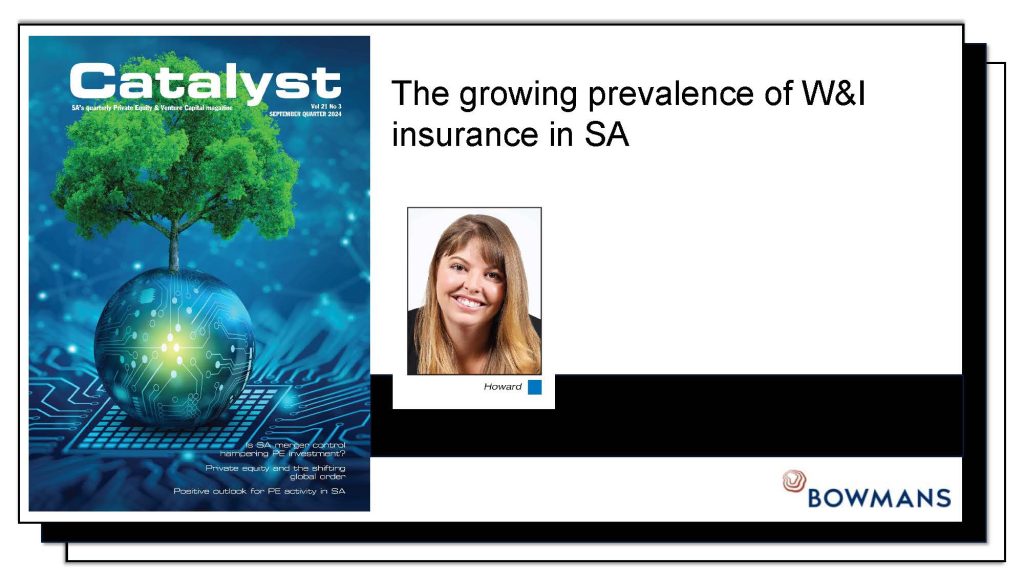Since the emergence of Warranty and Indemnity (W&I) insurance in the South African market, this form of insurance has gained momentum as a tool for getting deals done effectively and efficiently. Although traditionally utilised by players in the private equity (PE) space, W&I insurance is increasingly being used by corporate and trade entities.
Traditionally, the primary driver for using W&I insurance in PE deals has been that where PE funds are exiting an asset, they are required to use the proceeds of the sale to realise returns for their investors.
Accordingly, being liable for a number of years in respect of warranty claims can prove problematic once proceeds have been distributed to investors, and the concept of an escrow arrangement or holdback for future warranty claims is not attractive to PE funds.
In addition, PE funds have been reluctant to give operational warranties in respect of the target assets as they are not generally involved in the day-to-day aspects of the business. A further reason for the prevalence of W&I insurance in PE deals is that when PE funds acquire an asset, the selling parties are often founders and they, together with the existing management team, will remain involved or even reinvest in the business.
As such, maintaining positive working relationships with founders and management is a key priority for the success of the business, and using W&I insurance shifts any liability for warranty breaches from the seller to the insurer. This is because the W&I insurance product seen most frequently in the South African market is a no-recourse policy, which means that any amounts paid out by the insurer cannot be recovered from the seller.
Another advantage of W&I insurance is that the parties are more likely to engage in commercial negotiations where a broader, more reasonable set of warranties can be given, instead of the discussions being driven solely by a desire to limit potential recourse.
Finally, W&I insurance also has the advantage of mitigating against enforcement risk in cross-border deals because a claim is made against the insurer and not the sellers, who may be scattered across various jurisdictions.
These elements of W&I insurance have also been noted more recently by trade buyers and sellers and, therefore, we have seen the expansion of W&I insurance beyond the PE space.
However, despite the increasing prevalence of W&I insurance in South Africa, it still raises a number of questions, and it is not always clear to transacting parties how to get the best value out of this product. To clarify this, we have set out some frequently asked questions and responses on W&I insurance below.
What will typically be covered under a W&I insurance policy, and how can cover be maximised?
Broadly speaking, W&I insurance policies will cover loss arising from a breach of warranties resulting from matters that were unknown to the buyer, as well as any defence costs and gross-up costs. There will, of course, be limitations on the amounts and what can be claimed from the insurer, and these largely mirror what one would expect to see in a sale agreement.
Examples of such limitations will typically include de minimis amounts, below which a warranty claim cannot be made, retention amounts, and limitations on the total liability of the insurer under the policy. The thresholds at which the limitations are set will be negotiated between the insurer and the insured and will affect the pricing of the policy.
The quality and extent of coverage under the W&I insurance policy will fundamentally be driven by the extent and quality of the due diligence investigation that was undertaken in relation to the target asset. This is because the policy will only cover unknown risks and, as such, the insurer will seek to get comfort from the due diligence investigations that all risks have, to the extent reasonably possible, been uncovered and are known to the buyer.
Despite this review and examination of the due diligence reports, it is worth noting that the insurer will not seek to obtain reliance on the reports. Typically, areas that are not investigated, or are not adequately investigated as part of the due diligence process, will not be covered by the W&I policy. Accordingly, the best way to maximise cover under the W&I insurance policy is to ensure thorough due diligence has been undertaken on the target asset.
What will typically be excluded from cover under a W&I insurance policy and how should the parties deal with this excluded liability?
In addition to matters that are known to the buyer and items that have not been adequately investigated, there are a number of general exclusions that are typical for South African W&I insurance policies. These include any fines and/ or penalties other than those relating to tax, consequential and indirect losses, structural defects, purchase price adjustments, anti-bribery and corruption liabilities, and environmental pollution liabilities.
Liability for matters excluded from the W&I insurance policy should be negotiated between the buyer and the seller. Increasingly, the position in South Africa is that the seller is expected to stand behind such excluded matters, subject to market-appropriate limitations of liability.
What are the costs of W&I insurance and who is liable for these costs?
The cost of W&I insurance in South Africa was considered high in the past, being around 1.75% to 2.5% of the amount insured under the policy.
However, the global decrease in M&A activity in the United Kingdom and United States has meant that insurers are more willing to extend their reach into Africa. This competition has resulted in the decrease of premiums, and it is now common to see premiums in the range of 0.9% to 1.7% of the amount insured under the policy.
Traditionally, when used by PE funds, it was generally accepted that the buyer would bear the cost of the W&I insurance on the understanding that when the PE buyer eventually exits, they will see the benefit of a W&I policy, which is then paid for by the incoming buyer.
However, as more and more trade buyers are looking to make use of W&I insurance, the cost of the insurance is being more heavily negotiated and, although it is still more common for the buyer to pay the costs, there has been a rise in the premium being split between buyers and sellers.
What is the timing for putting a W&I insurance policy in place?
Often, transacting parties are reluctant to explore W&I insurance on the basis that it may delay a transaction. However, this is increasingly proving not to be the case because W&I processes can be managed in parallel with the negotiation of the transaction and insurers are eager to work within the existing deal timelines. Depending on the availability of the due diligence materials, the W&I processes would typically take between two and four weeks.
As the appetite for W&I insurance grows across the continent, dealmakers should seek out brokers and advisors to test the viability of this insurance for their transactions, even if it is not initially contemplated.
Janine Howard is a Partner | Bowmans.

This article first appeared in Catalyst, DealMakers’ quarterly private equity publication.
DealMakers is SA’s M&A publication.
www.dealmakerssouthafrica.com



